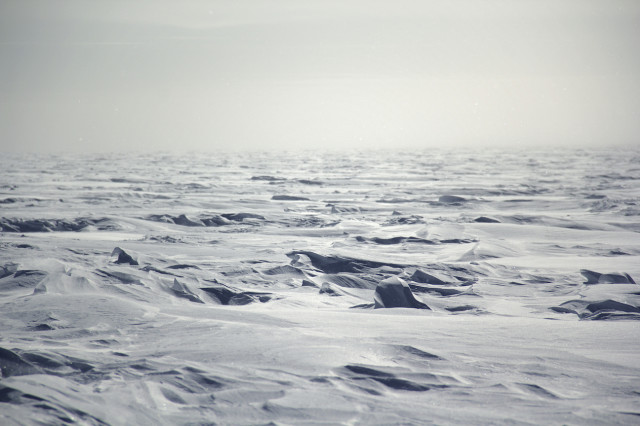
Refael Klein returns to the station after a few hours of skiing. The smoke in the sky is exhaust from the station’s power plant. (Photo by Hunter Davis)
SOUTH POLE JOURNAL
Refael Klein is blogging about his experiences as he spends a year working and living at the South Pole. Read his earlier posts here.
On a clear day at the South Pole, the horizon sits about 16 kilometers (10 miles) away.
We measure the visibility at any given point by referencing large wooden visibility markers that are anchored into the snow and run from the station at regular intervals to the north, east and south. The markers are painted black and the farthest ones are placed at almost 5 kilometers (3 miles), the minimum visibility required to land a plane on our ski-way.
For the past three days, the weather has been clear, windless and warm ( minus 28 Fahrenheit, minus 33 Celsius). I’ve taken advantage of these sublime conditions by indulging in a little outdoor recreation, exploring the vast barren polar landscape by cross country ski.

Refael Klein checks his bindings outside the Amundson-Scott South Pole Station. (Photo by Hunter Davis)
I don’t own a pair of skis but, fortunately, there is a big collection of Nordic equipment on base that’s free to rent.
Most of the stuff is pretty old but in good shape, thanks to the generosity of a few resident ski experts who have taken it upon themselves to repair broken bindings, patch boots and help novices like me pick out the proper gear.
The skis I use are red, with red bindings, about 6-feet long (1.82 meters) and wax-less. I have two adjustable well-worn, nicked blue poles that look like they may have been used at one point to reenact a scene from The Three Musketeers. My boots are blue, which I like, because they match my poles. Also, they’re well insulated and have enough wiggle room for few chemical heat pads.
Sunday, I skied 8 kilometers (5 miles). Monday, I skied six. Today, I want to ski eight.
It’s beautiful out, perhaps the nicest day we’ve had at the South Pole since I arrived. I dress lightly, foregoing my down jacket and substituting a thin, red polypropylene neck gator for my black, wool balaclava. The sun is sitting high on the horizon and I know I’ll warm up quickly, especially with no wind chill.
Outside the station’s main entrance, I clip into my bindings and I take off north, paralleling the visibility markers. The first mile, I’m on groomed “road” and I get a good glide with each stride.
After a few minutes, my goggles fog up. I stop and swap them out with an extra pair that I have stuffed down my shirt. Over the past two days, I’ve learned that it’s imperative to pack two pairs of goggles if you plan to stay outside for any length of time. They ice up quickly with condensation, and if you keep one stuffed down your clothes, next to your skin, they thaw out rapidly and you can switch between them endlessly.
Where the road ends, the wilderness begins. Snow at the South Pole is like no other snow I’ve ever encountered. It has a rough texture and if you were to run your hand along the surface, it would feel like the finest setting on a cheese grater. Needless to say, you don’t get much glide, but it’s still more efficient than walking. As a beginner, I move along at about 8 kilometers per hour (5 miles an hour).
Wind whipping over the Antarctic plateau blows snow into bizarre structures that look like miniaturized 1960’s concept car bodies. Typically, these formations are no bigger than a foot tall, but they can be many yards long.

Strastrugi snow formations on the Antarctic Plateau. (Photo by Hunter Davis)
They are called strastrugi, and cover the landscape in an endless maze of surreal shapes. The strastrugi are hard to climb over and corrupting their sleek look with a pair of ski tracks feels like putting a dent in a Jeff Koon’s balloon animal sculpture. I try my best to avoid them. I blaze trail in an endless zig-zag.
Time disappears into the landscape. The horizon never moves, and with the last visibility markers behind me, I begin to judge my distance by the soreness of my legs.
It is endlessly white in every direction. So empty and so devoid of contrast that I can’t help but become hyperaware of every movement I make and every scratch, swoosh and knock that my skis, clothing and body generate. My breath is the loudest sound of all and fills the landscape for hundreds of miles.
My presence is maddening and makes me feel at odds with the pristine landscape — dead still and quiet. I stop, breathe in deeply, and try my hardest not to move, think or exhale. Staring into the distance, I see nothing, only white. It is cold, my body is numb. The landscape has no smell and my taste buds are frozen.
But no matter how hard I focus, I can still hear myself standing still.
Look for Refael Klein’s weekly blogs from the South Pole here on Science World.





















Comments are closed.